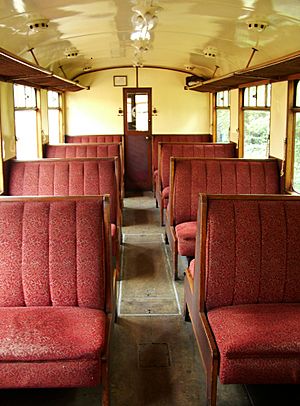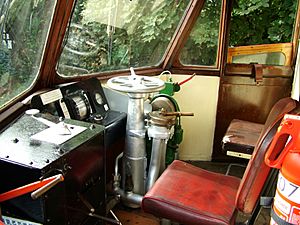GWR railcars facts for kids
Quick facts for kids GWR railcars |
|
|---|---|
| In service | 1933–1962 |
| Constructed | 1934–1942 |
| Number built | 38 |
| Operator(s) | Great Western Railway British Rail (Western Region) |
| Specifications | |
| Track gauge | 4 ft 8 1⁄2 in (1,435 mm) |
The GWR railcars were a special type of train used by the Great Western Railway (GWR) in the United Kingdom. These trains were among the first modern diesel multiple units (DMUs) in Britain. They started running in 1933 and became very popular. They were used regularly until the 1960s. At that time, newer diesel trains from British Rail took their place.
Contents
What are GWR Railcars?
GWR railcars were self-propelled trains. This means they carried their own engine and did not need a separate locomotive to pull them. They were designed to be fast and efficient. This made them perfect for carrying passengers on shorter journeys. They were also used for express services on some routes.
Early Diesel Trains
These railcars were quite advanced for their time. They used diesel engines, which was a new idea for passenger trains in Britain. Most trains before them used steam engines. Diesel engines were cleaner and more efficient. They also allowed the trains to accelerate faster.
Streamlined Design
Many of the GWR railcars had a very modern and sleek look. Their bodies were streamlined. This means they were shaped to reduce air resistance. This design helped them go faster and use less fuel. It also made them look very futuristic!
History of the GWR Railcars
The first GWR railcar was introduced in 1933. It was a big success. Because of this, the Great Western Railway ordered many more. In total, 38 of these railcars were built between 1934 and 1942. They were built by different companies, including AEC and Park Royal Vehicles.
Where They Ran
These railcars were used on many different routes across the GWR network. They were especially good for services that needed to be fast and frequent. For example, they were used for services between London and Oxford, and on lines in the West Country. They helped connect towns and cities more quickly.
Life During World War II
During World War II, some of the railcars were changed. They were used to carry parcels and mail instead of passengers. This showed how useful and adaptable they were. After the war, they went back to carrying passengers.
End of an Era
The GWR railcars served for many years. They were a familiar sight on British railways. However, by the 1960s, newer and more powerful diesel trains were being built. These new trains were part of British Rail's plan to modernize the railway system. The GWR railcars were slowly replaced by these "first generation" diesel multiple units. The last GWR railcar was taken out of service in 1962.
Legacy of the Railcars
Even though they are no longer in regular service, the GWR railcars left an important mark. They showed that diesel trains could be reliable and efficient. They paved the way for the many diesel trains that run in Britain today. Some of these historic railcars have been preserved. You can sometimes see them at railway museums or on special heritage lines.
Images for kids
See also
 In Spanish: Automotores diésel del GWR para niños
In Spanish: Automotores diésel del GWR para niños





